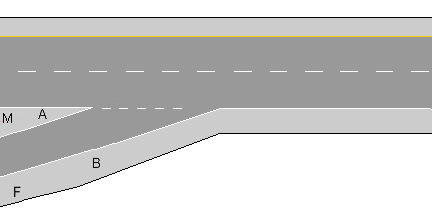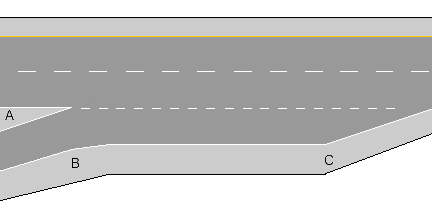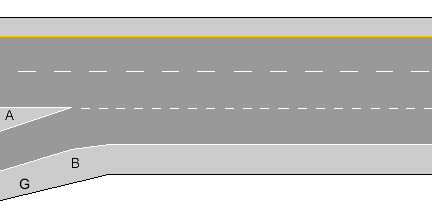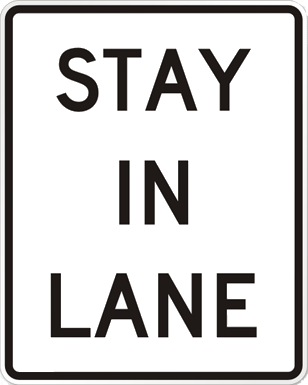
Bad sidepath
There is a hidden hazard with this design:
If a driver is waiting to make a left turn across the bicycle sidepath, oncoming vehicles can hide a bicycle heading toward the sidepath intersection from the same direction the driver came from:
- The driver approaches the intersection intending to turn left across the sidepath.
- Oncoming traffic keeps the driver from making the left turn and from seeing the sidepath on his left.
- The cyclist approaches the intersection on the part of the sidepath hidden from the driver.
- The cyclist starts to cross the intersection while the driver and the cyclist are hidden from each other.
- A gap in oncoming traffic occurs, the driver turns left across the sidepath, and hits the cyclist.
If two sidepaths are provided, one on each side of the road, which are each one-way in the same direction the nearest vehicle lane travels, this hazard is not there.
Any two-way bike path must be at least 60 feet from the parallel road.
The page author will not drive on or deal with businesses on streets made in this way.
Liberals and democrats seem to have the mantra that the slower a vehicle goes, the higher the gas mileage will be. This is not true in most vehicles with transmissions. This is actual data the page author collected from cars he actually drove.
| SPEED | CAR 1 2002 Pontiac Bonneville |
CAR 2 2012 Chevrolet Cruze |
CAR 3 2010 Mazda 5 Wagon |
CAR 4 1957 Chevrolet Turboglide* Accelerating |
CAR 4 1957 Chevrolet Turboglide* Cruising |
||||||||||
|---|---|---|---|---|---|---|---|---|---|---|---|---|---|---|---|
| GEAR | RATIO | MPG | GEAR | RATIO | MPG | GEAR | RATIO | MPG | PHASE | RATIO | MPG | PHASE | RATIO | MPG | |
| 5 | 1 | 2.92 | 7.2 | 1 | 4.58 | 6.2 | 1 | 3.62 | 5.2 | 1 | 2.67 | 5.6 | 1 | 2.67 | 5.6 |
| 10 | 1 | 2.92 | 7.2 | 2 | 2.96 | 9.6 | 1 | 3.62 | 5.2 | 1 | 2.67 | 5.6 | 2 | 1.60 | 9.4 |
| 15 | 2 | 1.59 | 13 | 3 | 1.91 | 15 | 2 | 1.92 | 9.7 | 1 | 2.67 | 5.6 | 3 | 1.00 | 15 |
| 20 | 2 | 1.59 | 13 | 3 | 1.91 | 15 | 2 | 1.92 | 9.7 | 2 | 1.60 | 9.4 | 3 | 1.00 | 15 |
| 25 | 2 | 1.59 | 13 | 4 | 1.44 | 20 | 3 | 1.28 | 15 | 2 | 1.60 | 9.4 | 3 | 1.00 | 15 |
| 30 | 3 | 1.00 | 21 | 5 | 1.00 | 28 | 3 | 1.28 | 15 | 2 | 1.60 | 9.4 | 3 | 1.00 | 15 |
| 35 | 3 | 1.00 | 21 | 5 | 1.00 | 28 | 4 | .938 | 20 | 2 | 1.60 | 9.4 | 3 | 1.00 | 15 |
| 40 | 3 | 1.00 | 21 | 5 | 1.00 | 28 | 4 | .938 | 20 | 3 | 1.00 | 15 | 3 | 1.00 | 15 |
| 45 | 4 | .705 | 30 | 6 | .74 | 38 | 5 | .692 | 27 | 3 | 1.00 | 15 | 3 | 1.00 | 15 |
| 50 | 4 | .705 | 30 | 6 | .74 | 38 | 5 | .692 | 27 | 3 | 1.00 | 15 | 3 | 1.00 | 15 |
| BEST | 4 | 45 MPH | 6 | 45 MPH | 5 | 45 MPH | 3 | 40 MPH | 3 | 25 MPH | |||||
Notice that 45 MPH is the lowest speed that all of these cars achieve their highest gas mileage. When their transmissions downshift at lower speeds, their gas mileages are reduced by the change in gear ratio.
* Note these things about the 1957 Chevy
- This car as sold was set up for performance, not fuel economy, so it has
lower gas mileage.
- The Turboglide transmission stays in the highest phase (gear) until a need
for acceleration or power actually occurs. So when the engine is lightly loaded,
it still has the good mileage of the highest gear.
- The Turboglide transmission actually obeys the expectations of the liberals
over a larger range of speeds because it stays in the highest gear as shown above.
Politicians are NOT trained traffic engineers, but they seem to believe that being elected to office makes them traffic experts.
Often they have the stupid idea of designing a road for a speed 10 mph higher than the intended speed limit will make the road safer. But it actually makes people drive faster than the speed limit because the road seems designed for it.
This is mainly a problem of the politicians (usually Democrats) wanting traffic to flow at a lower speed than the design speed of the road. Instead of accepting the design speed of the road as the speed traffic will naturally flow at, they install obstacles to try to lower the speed traffic flows at. Too often they use speed bumps or humps.
Speed bumps are abrupt changes in pavement level over short distances.
Speed humps are more gentle changes over a longer distance.
Speed bumps and humps cause the following troubles:
- Damage to vehicles from the abrupt motion
- Damage to vehicle ground-effect devices that hit the bump or hump
- Fire engines, trucks, and limousines getting high-centered on the bump or hump
- Emergency vehicles moving at high speed launched into the air
- Damage to trailers towed by vehicles when the tongue hits the bump or hump
- Damage when the trailer tongue hits the road as the towing vehicle tilts from the bump or hump
- Severe discomfort to disabled people and people with bad backs or joint problems
- Cargo jarred loose
- Cars speeding up between the humps
- Lower gas mileage due to the very low speeds and changing speeds
The page author will not drive on or deal with businesses on streets made in this way.
There are three different ways traffic on an entrance ramp is added to freeway traffic:
|
The YIELD configuration has:
- A YIELD sign on the ramp - No sign on the freeway - No acceleration lane. |

|

|

|
|
The MERGE configuration has:
- A MERGE sign on the freeway - No sign on the ramp - A properly designed acceleration lane. |

|

|
|
|
The ADDED LANE configuration has:
- An ADDED LANE sign on the freeway - An ADDED LANE sign on the ramp - The ramp gets its own new lane. |

|

|
The Yield configuration is cheaper to build, but is dangerous.
Using the Yield configuration is dangerous because:
- The driver must make a decision to either accept a gap in freeway traffic or to stop and wait for a larger gap.
- The driver must simultaneously look forward to follow the ramp and avoid traffic, and look back over a shoulder for approaching gaps.
- If the driver stops, the driver behind might run into the stopped car while watching behind for a safe gap.

MERGE CHEAT
The problem: The merge cheat stops at the end of the freeway exit ramp instead
of entering the merge lane.
This causes the following problems:
- Instead of merging properly, the merge cheat stops at the end of the ramp (orange line) until he can directly enter the left lane (orange arrow).
- Apparently the merge cheat wants to turn left at the next intersection.
- When the merge cheat stops, the driver behind does not expect the stop and often rear-ends the merge cheat's car.
- In heavy traffic, the merge cheat blocks the ramp until the way clears to cross to the left lane. This can back ramp traffic up onto the freeway.
- In practice, the page author has always been able to merge into traffic and then change lanes with no trouble (assuming nobody stops).

Possible remedies:
- STAY IN LANE sign at the end of the ramp.
- A solid white line for the first 100 feet.
- A double solid white line for the first 100 feet.
- Control the ramp with a traffic signal.
(Orange markings added to image by page author)
This is usually the result of the government in charge deciding to not fund traffic signal maintenance to spend the money elsewhere. This causes the following problems:
- Some traffic never gets a green light because the detector quit. Vehicles violate the light to move.
- A failed detector often fails in the detected position, causing the signal to act on traffic that is not there.
- When a detector fails, the signal technician turns on the RECALL switch for the signal phase. This also causes the signal to act on traffic that is not there.
- When a signal stays green unnecessarily, it keeps other traffic stopped, wasting time and energy.
- If the light gets out of sync with other signals because detectors are not working, progression of green lights may be lost. This causes more stops, wasting energy.
- Often when a street is repaved, the loop detectors are destroyed when the pavement is milled. This causes the above problems until new loops are cut and placed.
- When traffic detectors fail, often the signal uses a very short cycle, giving time for 3 cars to pass in each direction.
This always wastes gasoline.
- This affects all vehicles except hybrid vehicles.
- When a vehicle moves at uniform speed in a straight line, it uses only the amount of energy needed to overcome dynamic friction.
- When a vehicle stops, all of its kinetic energy is wasted in the brakes. New energy is needed to make the vehicle get up to speed again.
- When a vehicle slows down, the kinetic energy removed from the vehicle is wasted in the brakes. New energy is needed to make the vehicle get up to speed again.
- Low speed limits lower gas mileage (see above).
- Lack of progression of green lights causes more stops, wasting energy.
- Use of stop signs for speed control is stupid. It wastes time, energy, and does not work to keep speeds down. Drivers speed up between the stop signs.
- Use of all-way stops because no money is available for traffic lights is stupid. It wastes time and energy and disrupts any progression pattern.
- Even worse is when a government overdesigns a road and then posts lower speed limit to
"make it safer".
Half of the traffic will move at the real design speed of the road, not the lower speed the politicians wanted.

YELLOW TRAP

FYA FIX
Yellow trap occurs only when all of these conditions are simultaneously met:
- Left turns can be made through gaps in traffic during the circular green.
- Both circular greens for the same street are displayed together.
- One circular green ends before the other one does.
- The left-turning driver with the shortened green expects oncoming traffic to stop.
- The left-turning driver with the shortened green turns in front of oncoming traffic with a green light.
- If drivers are not wary, an accident happens.
Yellow trap has been prohibited in the Manual on Uniform Traffic Control
Devices (MUTCD) since 2005.
It must be removed or warned with a sign.
Governments have allowed yellow trap for the following reasons:
- Officials do not know what yellow trap is or that it is happening.
- Officials do not know that yellow trap has been prohibited since 2005.
- Officials do not want to spend the money needed to prevent yellow trap.
- Signals are inspected during the day, when yellow trap is rare. Yellow trap is occurring at night when traffic is light.
- The untrained electrician or policeman in charge of the signals does not know how to stop yellow trap.
- The untrained electrician or policeman in charge of the signals installed the signal wrong, causing yellow trap.
- Officials refused to pay for flashing yellow arrows in both directions on the same road.
- Officials won't pay for the required signs warning that yellow trap can happen.

FYA BAD INSTALL YELLOW TRAP

FYA CORRECT INSTALL
Governments have misused flashing yellow arrows in the following ways:
- Improperly installed FYA causing yellow trap
- Improperly installed signal or FYA causing second yellow trap (right turn green arrow conflicts with FYA left clearing on yellow)
- Improperly installed FYA causing third yellow trap (signal reservices pedestrian phase that inhibits FYA)
- Improperly installed signal causing little yellow trap (oncoming yellow lights end at different times)
- Improperly installed signal causing green trap (signal starts oncoming green lights at different times (with no left turn signals)
- Failing to put FYA signal faces on opposite approaches on the same street (can't prevent yellow trap without both).
- Using FYA signal faces with the old signal sequences (can't prevent yellow trap).
- Using FYA with improper geometry for permissive turns.
- Misguided government officials think protecting pedestrians is more important than preventing yellow trap.
- Misguided government officials think protecting emergency vehicles is more important than preventing yellow trap.
- Misguided government officials don't think signals must be reprogrammed during lane-closing construction to prevent yellow trap.
- Any sequence that allows the flashing yellow arrow to end before its oncoming circular green
- Used FYA where it is not allowed.
The usual cause of a FYA yellow trap is a badly trained signal technician not understanding yellow trap prevention.
- This person leaves the controller phasing the same and just rigs a flasher on the adjacent circular green output.
- Officials need to keep an eye on what their technicians are doing.
- Contracts with local electricians are NOT good enough with FYA.
This is dangerous, not to pedestrians, but to cyclists and motorists.
- This happens because cyclists do not like to stop at intersections. When they reach an intersection, they go on through without stopping.
- When a bicycle stops, the brakes waste all of its kinetic energy. The cyclist must make new energy to get the bicycle up to speed again.
- Pedestrian crosswalks and signals are designed for a top speed of 4 mph.
- The problem is, when a cyclist goes on through without stopping, he is visible to other traffic for a very short time.
- Often the bicycle is coming up behind a motorist on the road. In this case, the driver probably cannot see it.
- Street trees can also hide a bicycle from a motorist until the last second.
- The crash happens when the motorist makes a left or right turn and either crashes into the bike or the bike hits the vehicle.
Bicycles belong on the road or a dedicated bicycle path, not on the sidewalk. And bicycles must obey all traffic laws.
This is dangerous because not all vehicles have the needed range of vision to use it.
- Many vehicles do not have the range of vision needed for a driver to back into a parking space.
- In many vehicles, the driver cannot see the painted lines between the spaces when backing.
- Many drivers do not have the skill necessary to back into a parking space.
- The problem is that the idiot who thought this up was thinking of pedestrian safety, not total traffic safety.
The page author will not drive on or deal with businesses on streets made in this way.
This is dangerous when the cable partially obscures a signal lens, making it hard to see.
- The cable often obscures the shaft of an arrow on an arrow lens. This makes the arrow hard to see and can obscure the type of signal from the driver.
- Multiple cables can totally hide a signal lens from a driver.
- Cables must be either higher than or behind the signal lenses.

This is a dangerous implementation of a pedestrian hybrid beacon, usually done because
it is cheaper than doing it the correct way.
The problem is that cross street traffic is not controlled by the beacon.
The MUTCD says that a pedestrian hybrid beacon should be at least 100 feet away from an
intersection.
If the trail or bikeway is closer, a standard traffic signal must be installed to control
cross traffic too.
The problem is that there are too many different traffic movements in a small area.
This makes a dangerous situation because drivers on the cross street can't see that the
beacon has been activated.
This is dangerous!
The trail or bikeway should either come up next to the road (as in the protected
intersection) with a standard traffic signal,
or it should be moved at least 100 feet away from the intersection to use with the
hybrid beacon.